Rick's b.log - 2018/04/06
You are 18.225.175.230, pleased to meet you!
Rick's b.log - 2018/04/06 |
|
| It is the 21st of November 2024 You are 18.225.175.230, pleased to meet you! |
|
mailto: blog -at- heyrick -dot- eu
So... They are available, but they aren't so cheap. The base price is around €30 upwards.
From time to time, Amazon does a special "flash sale" on one of the items in my wishlist. I noticed such a sale on an LCD display panel. No so large at 3.5", but with an HDMI input so no weird interfacing to deal with. List price was around €30 (it was the cheapest non-SPI one I found), Amazon was offering me a third off if I purchased it in the next fifteen minutes.
It arrived today, from having been ordered on Tuesday (and fulfilled two hours later in their big Italian warehouse, a name like Piacenza (probably spelled that wrongly)).
Here's the box:
Inside is a DVD-R with instructions (scant, mostly in Chinese) and some custom builds of Raspbian and something else, plus a driver (perhaps for other versions of Linux?). Not a whiff of a datasheet...
Under that, some random bits of plastic that comprise a sort of... thing upon which to mount the screen on the Pi.
The immediate problem that I ran into was that it doesn't work on any of my Pi devices. It can't work on the Pi2 as that's an always-on server hooked to the big monitor. It doesn't fit the Pi 1 because the headphone jack on the display clashes with the ethernet socket of the Pi, and it doesn't work with the Pi Zero because weirdo tiny connector.
But there was one board that it did manage to fit...
And this, ladies and gentlemen, is the first time I've had any sort of stable output from the Beagle xM that wasn't using s-video!
There was no magic, I just shoved the back-to-back HDMI thingy into both units and powered up. Actually, the display was powered from the Beagle (standard USB 5V), which certainly seems to have a predilection for turning the USB ports off and back on again during start-up. And... has the Beagle always been that slow at getting going? I guess the Pi has spoiled me here...
There is a touch screen, you can see the connections for it to the right of the display. It is probably limited as it is going to be resistive (going by the stylus, plus capacitive is more expensive). I cannot use the touch screen as it appears to communicate using SPI or something else on the GPIO. At any rate, I'm not sure it would be much use with RISC OS, a system very firmly in multiple-mouse-button land.
Some random observations:
So there you have it. A display that finally works well with the Beagle!
As I was writing this, I remembered the Pi Zero had a little widget to convert the tiny video output to a more standard HDMI type. So I plugged the Pi Zero into the screen and booted up OSMC. I don't think I'd be able to use the touch features, but this in a box with a plug in mouse and some USB - could make an interesting little media player? Fair enough, the display isn't good (it's nothing like looking at my phone), but it's arguably better than the display on my DVD player!
Anf finally, since this is Rick's b.log, here's the part you've been waiting for...
The touch screen is handled by the IC just below the left side of the GPIO connector. It is an XPT2046 touch screen controller.
To the lower left (below the metal can of the 27MHz crystal) is a CS4334K 24 bit 96kHz stereo DAC to convert the audio data into analogue sound.
And, of course, the elephant in the room is the RTD2660H flat panel display driver. It seems that the device can support various function keys, IR, on-screen display, analogue RGB plus composite video, and it's an 8051 core. Impressive.
The video panel is 480×320. While the instructions say that it'll support down to this resolution, the EDID doesn't provide anything smaller than 640×480, so that's what RISC OS used. It is a TFT LCD, supporting up to 65536 colours with an aspect ratio of 8:5.
This is incomplete/liable to change as I have not used it much yet.
Pros:
And the Cons:
All in all, something to play with.
3.5" LCD display
Something I have wanted for a while is a better quality of display that I could add to one of my ARM boards. Something better than the little 128x64 OLED panel. I mean, the OLED is great for an always-there status, but with a monitor for the Pi and a monitor for the PC, it becomes a problem when switching stuff around means messing with all sorts of things.
What would be nice is a little medium-resolution display module for a device that can mostly "do its stuff" but not run entirely without visual feedback. I also wanted a display device that accepted HDMI input because this should imply that it'll be more or less plug-and-play on the ARM boards. An SPI display, less so.
Well, they reduced the price from "I don't know, I'll have to think about it" to "about the same as a meal for two at McDo". So I prodded the "Buy it now dammit!" button and the order was placed.

Under that, the goods:
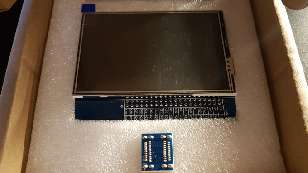
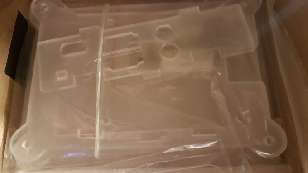
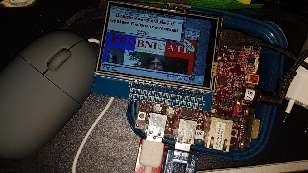
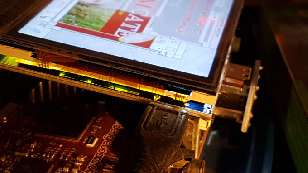
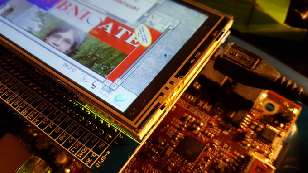
Why are these important? Because they are interpreted as the Delete key and the Enter key. The initial system setup (using RISC OS 5.22) was performed using Chars and a TaskWindow and picking each character with the mouse. Once I'd moved over to 5.23, I had to go find a keyboard. ☺
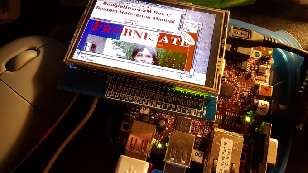
Something to think about, at least...
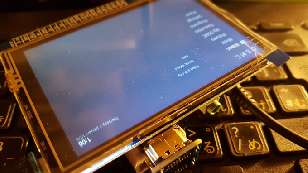

On the other side of the GPIO connector is a 25D40 4Mbit serial Flash (512KiB).
Below that is another IC that has had its markings removed, yet looks suspiciously similar. I wouldn't be surprised if this wasn't some sort of Flash as well.
Rick, 7th April 2018, 18:06
It was a little shimmery at 576i (50Hz), switching to 576p cured that, and the display was happy all the way up to 1080p (50Hz).
Nice! Stood there holding the display (powered from the receiver's USB port) and watched a documentary on NHK World.
| © 2018 Rick Murray |
This web page is licenced for your personal, private, non-commercial use only. No automated processing by advertising systems is permitted. RIPA notice: No consent is given for interception of page transmission. |